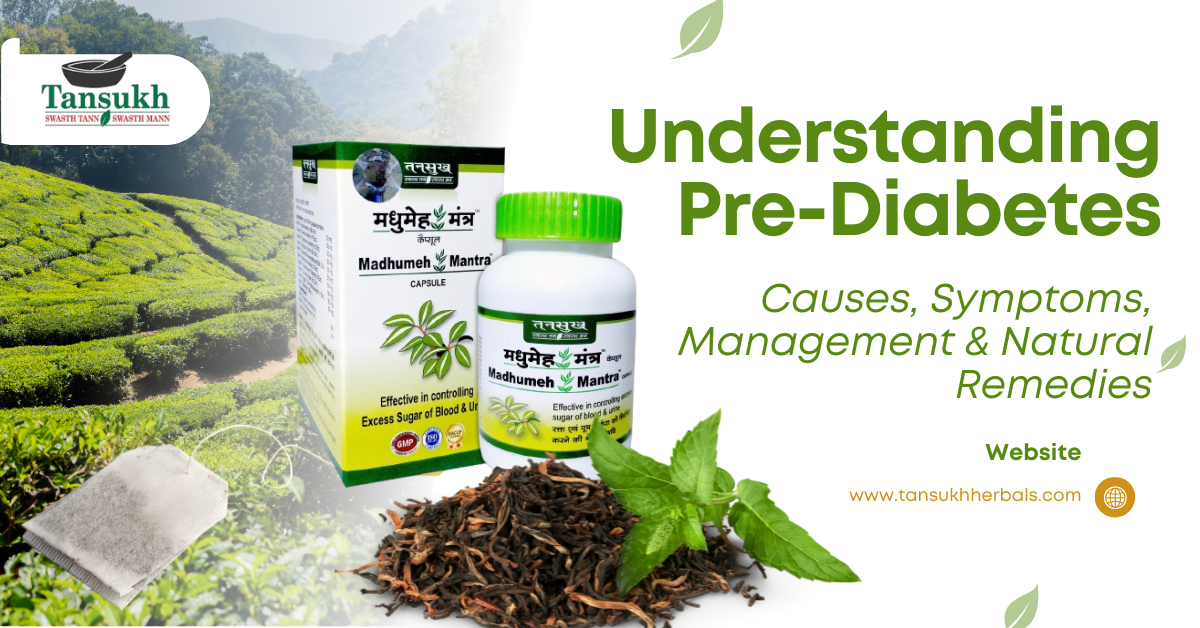
Understanding Pre-Diabetes: Causes, Symptoms, Management & Natural Remedies
What is a Pre-Diabetic Condition?
A pre-diabetic condition, also known as impaired glucose regulation or impaired fasting glucose, is a stage where an individual’s blood sugar levels are higher than normal but not high enough to be diagnosed as diabetes. This condition serves as a warning sign, indicating an increased risk of developing type 2 diabetes, heart disease, and other metabolic disorders.
When we eat, the body breaks down carbohydrates into glucose, which then enters the bloodstream. Insulin, a hormone produced by the pancreas, helps regulate glucose levels by allowing it to enter the cells for energy. However, in a pre-diabetic state, the body either:
- Produces insufficient insulin: The pancreas doesn’t produce enough insulin to regulate blood sugar levels effectively.
- Develops insulin resistance: The body’s cells become less responsive to insulin, preventing glucose from entering them efficiently.
This leads to elevated blood sugar levels, increasing the risk of various health complications.
Types of Pre-Diabetes
Pre-diabetes can manifest in two primary ways:
- Impaired Fasting Glucose (IFG) – Blood sugar levels remain higher than normal after an overnight fast.
- Impaired Glucose Tolerance (IGT) – Blood sugar levels spike more than normal after consuming a sugary meal or drink.
Risk Factors for Pre-Diabetes
Several factors can contribute to the development of pre-diabetes, including:
- Family History – Having a first-degree relative with diabetes increases your risk.
- Age – People aged 45 and above are at higher risk.
- Obesity – A BMI of 30 or higher is a significant risk factor.
- Physical Inactivity – A sedentary lifestyle with less than 150 minutes of moderate exercise per week can contribute to insulin resistance.
- Ethnicity – Individuals of African American, Hispanic, Native American, and Asian American descent are more prone to pre-diabetes.
- Poor Diet – Consuming a diet high in processed foods, sugars, and unhealthy fats increases the risk.
- High Blood Pressure & Cholesterol – These conditions often coexist with insulin resistance, leading to metabolic issues.
If left unmanaged, pre-diabetes can progress to type 2 diabetes, leading to severe complications such as heart disease, kidney failure, and nerve damage.
Symptoms of Pre-Diabetes
Most people with pre-diabetes do not exhibit noticeable symptoms. However, some signs to watch out for include:
- Increased thirst and frequent urination
- Unexplained weight gain or difficulty losing weight
- Fatigue and sluggishness
- Blurred vision
- Dark patches of skin (acanthosis nigricans), typically around the neck or armpits
- Slow-healing wounds or frequent infections
How to Manage Pre-Diabetes Effectively
Managing pre-diabetes requires a combination of lifestyle changes, dietary modifications, regular exercise, and natural supplements. Below are essential steps to help regulate blood sugar levels and prevent type 2 diabetes.
1. Lifestyle Changes
- Exercise Regularly: Aim for 150 minutes of moderate-intensity aerobic exercise or 75 minutes of vigorous-intensity exercise per week.
- Weight Management: Losing 5-10% of body weight can significantly reduce diabetes risk.
- Get Quality Sleep: Aim for 7-8 hours of sleep per night to regulate metabolic functions.
- Manage Stress: Engage in yoga, meditation, and breathing exercises to control stress-related insulin spikes.
2. Healthy Dietary Modifications
- Eat Whole, Unprocessed Foods: Focus on vegetables, fruits, whole grains, lean proteins, and healthy fats.
- Follow a Low-Carb Diet: Reduce refined carbohydrates, sugars, and unhealthy fats.
- Increase Fiber Intake: Aim for 25-30 grams of fiber daily from sources like vegetables, whole grains, and legumes.
- Stay Hydrated: Drink plenty of water throughout the day to help regulate blood sugar levels.
3. Foods That Help Regulate Blood Sugar
- Leafy Greens – Spinach, kale, and collard greens help regulate glucose levels.
- Berries – Blueberries, strawberries, and raspberries contain antioxidants that improve insulin sensitivity.
- Nuts & Seeds – Almonds, walnuts, chia seeds, and flaxseeds offer healthy fats that stabilize blood sugar.
- Fatty Fish – Salmon, tuna, and mackerel are rich in omega-3 fatty acids, beneficial for heart health.
- Whole Grains – Brown rice, quinoa, and whole wheat bread provide sustained energy release.
4. Regular Health Monitoring
- Blood Glucose Testing – Monitor blood sugar levels, especially after meals.
- Hemoglobin A1c (HbA1c) Testing – Check every 3-6 months to track long-term glucose control.
- Blood Pressure & Cholesterol Monitoring – Regular tests help assess cardiovascular risk.
Natural Remedies for Managing Pre-Diabetes
Tansukh Madhumeh Mantra – A Natural Solution for Blood Sugar Regulation
For those looking for a natural, herbal approach to managing blood sugar levels, Tansukh Herbals offers Madhumeh Mantra Capsules & Granules. This Ayurvedic formulation is crafted with potent herbs that:
- Enhance insulin sensitivity
- Promote glucose metabolism
- Support overall blood sugar control
Incorporating the Madhumeh Mantra into your daily routine, along with lifestyle and dietary modifications, can be a holistic way to manage pre-diabetes effectively.
Explore Madhumeh Mantra Capsules Here: Madhumeh Mantra
Conclusion
Pre-diabetes is a serious but reversible condition. By making proactive lifestyle changes, adopting a healthy diet, and incorporating natural supplements, you can significantly reduce your risk of developing type 2 diabetes. Regular health monitoring and consultation with healthcare professionals are crucial for long-term well-being.
Take charge of your health today and make the right choices to prevent diabetes naturally!
Share

